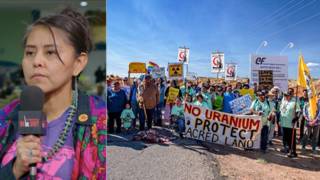
Topics
While the presidential candidates trade barbs and accuse each other of flip-flopping, they agree with President Bush on their enthusiastic support for nuclear power.
Sen. John McCain has called for 100 new nuclear power plants. Sen. Barack Obama, in a July 2007 Democratic candidate debate, answered a pro-nuclear power audience member, “I actually think that we should explore nuclear power as part of the energy mix.” Among Obama’s top contributors are executives of Exelon Corp., a leading nuclear power operator in the nation. Just this week, Exelon released a new plan, called “Exelon 2020: A Low-Carbon Roadmap.” The nuclear power industry sees global warming as a golden opportunity to sell its insanely expensive and dangerous power plants.
But nuclear power is not a solution to climate change—rather, it causes problems. Amory Lovins is the co-founder and chief scientist of Rocky Mountain Institute in Colorado. He makes simple, powerful points against nuclear: “The nuclear revival that we often hear about is not actually happening. It is a very carefully fabricated illusion … there are no buyers. Wall Street is not putting a penny of private capital into the industry, despite 100-plus percent subsidies.” He adds: “Basically, we can have as many nuclear plants as Congress can force the taxpayers to pay for. But you won’t get any in a market economy.”
Even if nuclear power were economically viable, Lovins continues, “the first issue to come up for me would be the spread of nuclear weapons, which it greatly facilitates. If you look at places like Iran and North Korea … how do you think they’re doing it? Iran claims to be making electricity vital to its development. … The technology, materials, equipment, skills are applicable to both. … The president is absolutely right in identifying the spread of nuclear weapons as the gravest threat to our security, so it’s really puzzling to me that he’s trying to accelerate that spread every way he can think of. … It’s just an awful idea unless you’re really interested in making bombs. He’s really triggered a new Mideast arms race by trying to push nuclear power within the region.”
Along with proliferation, there are terrorist threats to existing nuclear reactors, like Entergy’s controversial Indian Point nuclear plant just 24 miles north of New York City. Lovins calls these “about as fat a terrorist target as you can imagine. It is not necessary to fly a plane into a nuclear plant or storm a plant and take over a control room in order to cause that material to be largely released. You can often do it from outside the site boundary with things the terrorists would have readily available.”
Then there is the waste: “It stays dangerous for a very long time. So you have to put it someplace that stays away from people and life and water for a very long time … millions of years, most likely. … So far, all the places we’ve looked turned out to be geologically unsuitable, including Yucca Mountain.” Testifying at a congressional hearing this week, Energy Department official Edward Sproat said the price of a nuclear dump in Nevada’s Yucca Mountain has climbed to $90 billion. Slated to go online a decade ago, its opening is now projected for the year 2020. And even that’s optimistic. Rep. Jim Matheson, D-Utah, wants to block nuclear waste from passing through Utah entirely, and most Nevadans oppose the Yucca waste plan.
The presidential candidates are wrong on nuclear power. Wind, solar and microgeneration (generating electricity and heat at the same time, in smaller plants), on the other hand, are taking off globally, gaining billions of dollars in private investments. Lovins summarizes: “One of the big reasons we have an oil problem and a climate problem today is we spent our money on the wrong stuff. If we had spent it on efficiency and renewables, those problems would’ve gone away, and we would’ve made trillions of dollars’ profit on the deal because it’s so much cheaper to save energy than to supply it.”
The answer is blowing in the wind.











